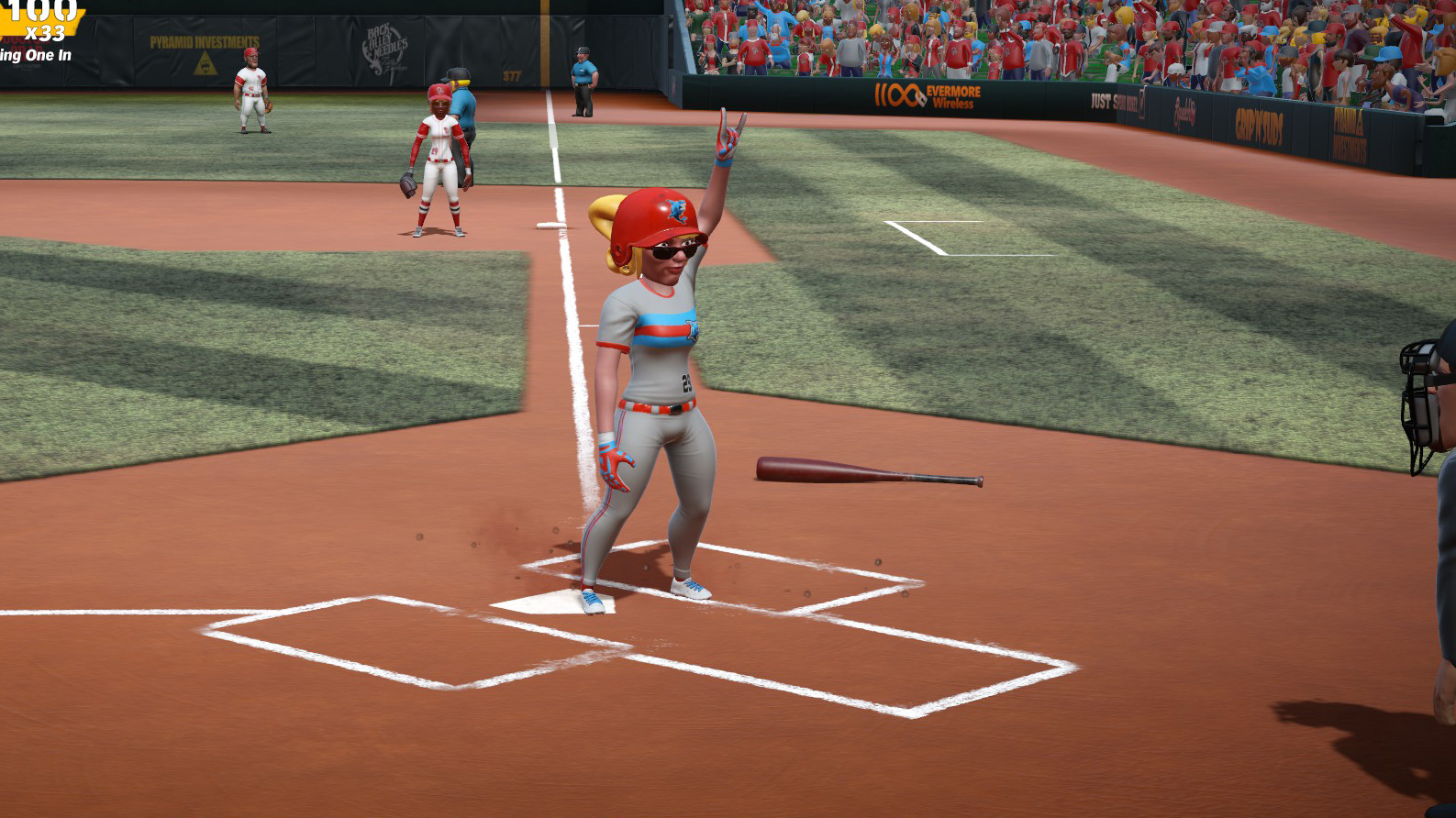Our Verdict
The improvements over the original make Super Mega Baseball 2 the best on-field baseball sim on PC.
PC Gamer's got your back
What is it? An arcade baseball sim
Expect to pay: $29.99/£23.79
Developer: Metalhead Software
Publisher: Metalhead Software
Reviewed on: Intel i7 7700HQ 2.8 GHz, 8 GB RAM, Nvidia GeForce GTX 1050Ti
Multiplayer: Online, or four-player local play
Link: Official Site
Super Mega Baseball was a brilliant arcade baseball sim that was let down by its lack of online play. The follow-up keeps the accessible hitting and pitching mechanics, smooths over some rough edges, and adds everything that was missing, including multiple online modes, a detailed team editor, and custom leagues. Basically, it does everything a sequel should do, and the result is the best on-field baseball sim on PC.
Online, you can play a one-off game or a custom tournament with friends, but the flagship mode is Pennant Race. You’re placed in a league with 14 opponents of a similar skill level, and you’ve got roughly a week to win as many games as you can before you’re shuffled into a different league that reflects your new rating.
I like the structure: the mini leagues make each match feel important. Once you’ve played one game it’s hard to tear yourself away, especially if you’re about to leapfrog the person above you in the standings. I was worried that not enough people would be playing, but crossplay with both PS4 and Xbox One means that finding your next game is always fast. (In the interest of fairness to players, Pennant Race currently requires using a controller).
Pennant Race’s five-inning matches are the perfect showcase of the series’ cat-and-mouse pitching and hitting system. As a pitcher, you select a pitch type, mark where you want to pitch, and then guide a second circle onto that mark during your wind up. Where that circle finishes is where you’ll pitch, and the closer it is to your original mark, the faster it’ll be.
Frozen ropes
As a batter, you can either try a regular hit or a power hit, which you charge up before you swing. The latter is more difficult to time, but you’re more likely to pierce the infield. The pitch location only reveals itself while the ball is thundering towards you, so you need to watch it early and figure out whether you should leave it alone or reposition the hitting marker and swing away.
There's just the right amount of complexity on both sides. Throwing a single good pitch is easy but stringing together a series of them is tricky. As well as trying to make sure they’ve got some whip behind them, you’re trying to out-think the batter, switching between balls—pitches thrown away from the strike zone—and strikes, as well as mixing in curveballs and sliders to keep your opponent on their toes.
It creates a deep system in which no two players will pitch or bat the same way. I’ve had games where I’ve been able to read pitches no problem, leaving balls thrown away from the plate and clobbering anything down the middle. But I’ve also had matches where the pitcher has got me to swing at bad ball after bad ball. I love the mind games and double bluffs it creates between pitcher and batter, each trying to predict what the other will do next.
Fielding is more of a mixed bag. Throwing is better than the original thanks to the addition of fielding errors, which you’ll make if you charge up a throw for too long, and I’ve lost games because of overthrown balls. That’s frustrating, but I like the fact that you have to concentrate on fielding now, and the threat of a mistake makes it all the more satisfying when you nail a double play with two hard throws. Sadly, controlling fielders before they throw is awkward. You can both jump and dive for balls, but it’s hard to know when to try it and when to just run towards the ball. It means you end up diving past the ball often, or jumping comically when you don’t need to.
The difficulty system—which I think every sports game should adopt—makes it easy to find the right level of challenge.
While the mechanics remain largely the same as the first game, the visuals are very different, and I like the change of style. It’s still arcade-y, but gone are the giant heads and bulbous eyes, replaced with players that look more life-like. Animations are less over-the-top, and it loses a sliver of its charm because of that: you’ll no longer see pitchers bawling on the mound when they get whacked over the fence. But it looks far more polished. I went back to the original, and the players now look blocky and alien.
Super Mega Baseball 2 is great offline, too. I haven’t yet found a way to exploit the AI, and the mistakes the CPU makes feel very human, like swinging at a curve ball that’s angling away from the plate. The difficulty system—which I think every sports game should adopt—makes it easy to find the right level of challenge: You set an ‘Ego’ rating of between 1 and 100 separately for pitching, batting, fielding and base-running, and you can adjust it in the middle of matches. I was playing lots of low-scoring games during my season, so I cranked up the pitching Ego and dialed down the batting, meaning both I and the CPU connected with more pitches.
Extra innings
Seasons now have 16 teams rather than 12, which is a nice boost, and you can add up to 32 in a custom league using the game’s creation tools (for more on them, Chris pitted a team of PC gaming heroes against a bunch of villains). You’re not getting official leagues or anything happening in the back office like player trades, which is a shame, but I’ve still grown attached to my team, and the ‘mojo’ system that boosts or dampens a player’s stats based on their performance provides continuity during a tournament.
It’s a better game than the original in every way.
The only problem I have with Super Mega Baseball 2, other than floaty fielding, is an occasional dip in online performance. Most games run smoothly, but some stutter. It’s never unplayable—from what I can tell, if the connection is bad then it will let the pitcher choose their pitch, wait for the batter’s connection to catch up, and then make the pitch, so the batter always gets a fair swing. But that leads to some jarring jumps forward in play, which is annoying.
I’m hopeful that Metalhead can sort those issues out, but even if they can’t then it’s not enough to ruin online play. I’ll be dipping in and out of Pennant Race for months to come, and I’m planning to set aside a chunk of time to create a marathon custom league with 30 teams.
It’s got its hooks into me: it’s a better game than the original in every way, and it nails the battle between pitcher and batter that’s at the heart of baseball. If you’re a fan of the sport, it’s a must-own.
The improvements over the original make Super Mega Baseball 2 the best on-field baseball sim on PC.
Samuel Horti is a long-time freelance writer for PC Gamer based in the UK, who loves RPGs and making long lists of games he'll never have time to play.



